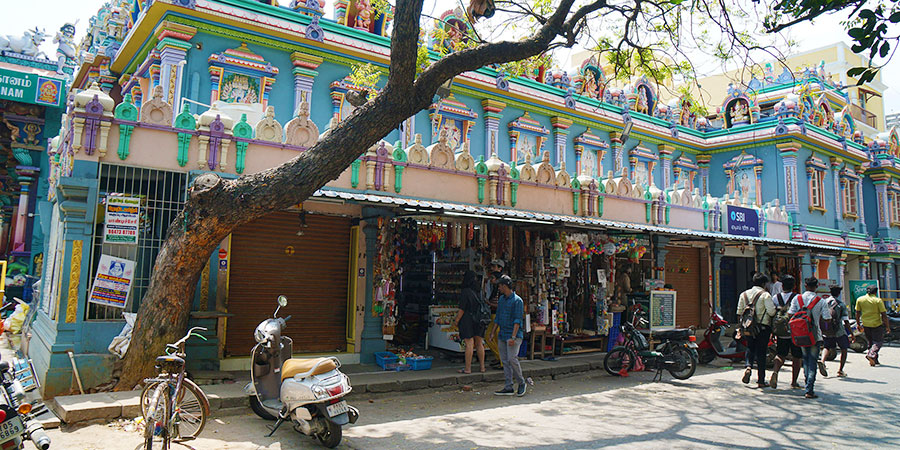Arulmigu Manakula Vinayagar Temple, Pondicherry
The Arulmigu Manakula Vinayagar Temple in Pondicherry is one such landmark that predates the French acquisition and is still standing after the city has become the part of India. The temple is dedicated to Lord Ganesha, fondly referred to as Sri Manakula Vinayagar, and even has a pet elephant that blesses the visitors.It is believed that the temple was established five centuries ago, and contains beautifully painted friezes – depicting stories from the Vedas and Upanishads. The temple exterior is decorated with skillfully crafted stucco figurines, an archetypal component of traditional Dravidian architecture.
If you are planning on visiting the Arulmigu Manakula Vinayagar Temple in Pondicherry to greet this important god of the Hindu pantheon, then this write-up would help you immensely.

Arulmigu Manakula Vinayagar Temple
|
Highlights of the Arulmigu Manakula Vinayagar Temple in Pondicherry
![]() Address: Manakula Vinayagar Koil St, White Town, Puducherry, 605001
Address: Manakula Vinayagar Koil St, White Town, Puducherry, 605001
![]() Opening time: 5.45 am to 12.30 pm, 4.00 pm to 9.30 pm
Opening time: 5.45 am to 12.30 pm, 4.00 pm to 9.30 pm
![]() Entry Fee: Free
Entry Fee: Free
![]() Famous for: Stunning temple architecture
Famous for: Stunning temple architecture
![]() Visit Duration: 1 hour
Visit Duration: 1 hour
![]() How to reach: Take public transport to visit the temple
How to reach: Take public transport to visit the temple
During the 17th and 18th centuries, several European countries had established their colonies in Asian countries including India. Among these colonial powers, the French occupied Pondicherry and the nearby regions – influencing the city’s culture and heritage. However, some establishments and landmarks remained unaffected by this change in power.
A Brief Overview of the Arulmigu Manakula Vinayagar Temple
The ancient Ganesha Temple of Pondicherry is an important landmark for the nearby Hindu community. This temple is built in traditional Dravidian architecture with an array of stucco figurines hosted on its outer walls and skillfully decorated friezes. These fixtures enhance the beauty of the temple, making it more attractive.According to Hinduism, each deity in a temple is conferred a new name. During the pujas and other religious ceremonies are conducted inside the temple premise, the deity is invoked with the given name. Here the deity is named Sri Manakula Vinayagar – meaning the deity who resides beside huge debris of sand.
The temple is shrouded in several legends and tales, among which one particularly famous. According to the tale, the French diplomat wanted to demolish the temple. Each time he tried to remove the idol from its intended position, the Ganesha idol would reappear miraculously on its position. After many futile attempts, the diplomat surrendered in his attempts.
The temple is an important spot in the itinerary of the tourists coming to the city.
The Architecture of the Arulmigu Manakula Vinayagar Temple, Pondicherry

|
Apart from that, the temple walls are decorated with colorful figures of Ganesha doing mundane activities like sleeping or playing with his friends. Each of these figures has their names, with a direct reference to the activities they are conducting. However, the primary shrine is quiet simple – a stark difference to the flamboyant exteriors. Another interesting feature of the temple architecture is its golden covered spire – one of the important features of the temple architecture.
While the visitor circumambulates the temple, they are greeted by several forms of Ganesha blessing the devotees. The temple premise is usually peaceful and has a divine aura attached to it.
Important Festivals Celebrated at the Temple
Ganesh Chathurthi is an important festival at the Arulmigu Manakula Vinayagar Temple, Pondicherry. During the festival, special ceremonies are organized in the honor of the deity and are attended by several devotees. Some other important celebrated at the temple premise includes ten-day Pavithra Utsavam and the monthly Chaturthi celebrations following the Hindu calendar.Temple etiquettes
If you are planning to visit this revered temple, then here are some of the pointers that could help you:1. Keep your footwear outside
The temples are a sacred place and the visitors are expected to remove the shoes or slippers before entering the complex. For the sake of convincing, visitors can leave the shoes inside the designated shoe stand or in your car.2. Before entering the temple cover up the head
Wearing dresses that cover the head, shoulder, and neck is always appreciated. In case you do not have such clothes, you can carry a spare shawl to cover the head and shoulders. This rule must be followed by both men and women.3. Do not take leather items inside the temple premise
Taking leather inside the temple premise is mostly prohibited by the priests; however, it is not a hard and fast rule. However, these small gestures can help you in bonding with the local culture.4. Accept the Prashad
Prashad is the divine offering to the deity of the temple. After the puja or the religious ceremonies, the priest distributes the Prashad among the people gathered in the temple. If offered, then accept the Prashad with both your hands – right hand over the left.
Other Attractions in Pondicherry:
Aurobindo Ashram - Submerged in the French-aesthetics

